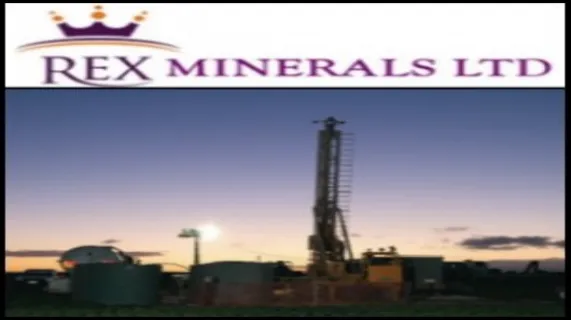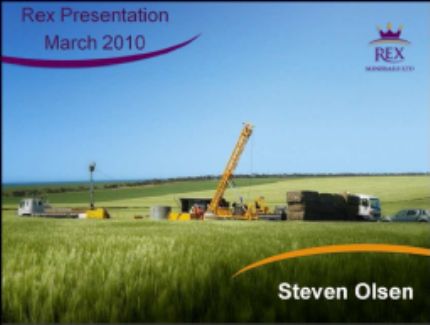
Rex Minerals Limited (ASX:RXM) New High-Resolution Survey Identifies Multiple Regional Copper Targets
Melbourne, Oct 12, 2009 AEST (ABN Newswire) - A detailed regional magnetic survey covering 60 kilometres of the Pine Point Copper Belt on the Yorke Peninsula in South Australia has opened up a host of new exploration targets on Rex Minerals Limited's (ASX:RXM) 100% owned tenements. In addition, two key holes recently drilled at the Company's Hillside Project highlight the potential for shallow large-scale copper mineralisation.
Rex's Managing Director Mr Steven Olsen said "If Hillside is any indication of what else Rex can expect to find along the Pine Point Copper Belt then the new magnetic survey will act like a beacon in testing the many copper prospects that exist close to surface."
"It's fair to say we have only just scratched the surface of this very interesting historic copper belt. The magnetic signature and detail of the survey at the Parara and White Cliff prospects are standout features for future exploration - possibly early next year given the focus we have at Hillside at the moment," he said.
Following the successful definition of magnetite-rich zones containing copper mineralisation from a detailed magnetic survey at Hillside (announced 24 August, 2009) a high resolution regional magnetic survey was completed over the entire Pine Point Copper Belt. The results from this survey have identified a number of linear magnetic features of variable size, including many that are much larger than the Hillside magnetic anomaly. Drill testing will be conducted to identify which of these features are related to copper mineralisation. Some of the larger magnetic anomalies including the Parara and White Cliffs target areas occur in close proximity to high grade historical copper mines similar to the Hillside Project.
At Hillside, Rex has commenced drill testing of the Parsee magnetic structure which was defined from the earlier high resolution magnetic survey. The first drill hole into the anomaly (HDD042) was immediately successful, intersecting significant copper mineralisation (chalcopyrite) hosted by magnetite from 100m to 145m down hole.
"Confirmation that the Parsee magnetic feature at Hillside contains substantial copper mineralisation is one of the most significant milestones at Hillside to date. This new evidence and the shallow nature of the mineralisation are likely to have a large influence on the overall economics of a new development opportunity at Hillside." Mr Olsen said.
A second drill rig at Hillside has completed initial drill testing of a geophysical electromagnetic (EM) anomaly, which was defined from a recently completed survey at Hillside (announced 17 September, 2009). Drill hole HDD039 has intersected a sequence of deeply weathered rocks containing a range of secondary copper minerals including native copper. Although only small amounts of native copper were intersected in the drill hole, the EM survey indicates that additional significant native copper could occur at Hillside.
Pine Point Copper Belt high resolution magnetic survey (South Australia)
Drilling results obtained at Hillside in the first half of 2009 identified a strong relationship between the iron mineral magnetite and copper mineralisation. This observation was very significant, as detailed magnetic surveys have the ability to accurately define where large concentrations of magnetite exist under cover. Given that the rocks that host the copper on the Pine Point Copper Belt occur almost exclusively under a thin layer (over 10m) of cover rocks, this discovery has the potential to open up a new frontier of discovery on the Yorke Peninsula. All drilling to date (42 drill holes) continues to show a strong relationship between magnetite and copper mineralisation.
The next step taken by Rex was to complete a large regional high resolution magnetic survey over the entire Pine Point Copper Belt. This survey was completed in early October. Multiple large scale targets exist along the Pine Point Fault Zone. Possibly the most significant of these are the Parara and White Cliffs targets where existing historical copper mines have already confirmed the presence of high grade copper in close proximity to the large magnetic anomalies identified in this new survey.
Hillside Prospect - Drilling results from the Parsee magnetic anomaly
In August 2009 Rex announced the results from a new high resolution magnetic survey over the Hillside Project. The results from this magnetic survey were particularly significant in revealing three major features that are interpreted to be three continuous magnetic zones known as Zanoni, Parsee and Songvaar. The largest magnetic feature is related to the central Parsee structure, which at the completion of the magnetic survey had not been tested with drilling. The majority of the high grade copper results completed to date at Hillside are interpreted to be related to the Zanoni magnetic zone, which is related to the western magnetic feature.
Drilling has just been completed over the Parsee structure close to the peak of the largest magnetic response recently defined. This drill hole (HDD042) intersected shallow secondary (chalcocite) copper mineralisation at a depth of 79.5m down hole, followed by primary copper mineralisation (chalcopyrite) hosted by magnetite from 100m to 145m down hole.
The continued association between the magnetite and copper has considerable implications for the Hillside project.
This result now opens up the potential for additional large scale copper mineralisation on the Parsee zone which is considered to be very similar in nature to that observed on the Zanoni. Assay results from HDD042 are expected to be received in early November.
Hillside Prospect - Discovery of secondary copper including native copper
Rex has also commenced drill testing of a geophysical electromagnetic (EM) anomaly which was defined from the recently completed survey at Hillside (Figure 5). The first drill hole (HDD039) has intersected a sequence of deeply weathered rocks containing a range of secondary copper minerals including native copper, atacamite and chalcocite.
The large thickness and shallow depth of this secondary copper mineralisation, combined with the size of the EM anomalies indicates that large near-surface supergene copper zones could exist at the Hillside project and Rex will investigate this with further drilling in tandem with the current program focussed on the primary copper zones. The presence of secondary copper mineralisation near the surface in close proximity to a large primary copper deposit has been reported previously on the Yorke Peninsula at the historical Moonta/Wallaroo copper deposits. Other large copper deposits, such as the Ernest Henry copper deposit in Queensland, also show similar primary and secondary mineralisation with an EM anomaly associated with native copper mineralisation.
Assay results for drill hole HDD039 have been returned, except for a section of drill core that contained the largest occurrence of native copper. The most significant assay results returned to date from HDD039 include:
- 108m @ 0.2% copper from 33m,
Including 34m @ 0.4% copper from 83m down hole,
- 15m @ 2.0g/t gold from 54m, and,
- 44m @ 3.1g/t silver from 28m.
Contact
Steven Olsen (Managing Director)
or Janet Mason (Company Secretary)
Phone: +61-3-5337-4000
E-mail: info@rexminerals.com.au
| ||
|









